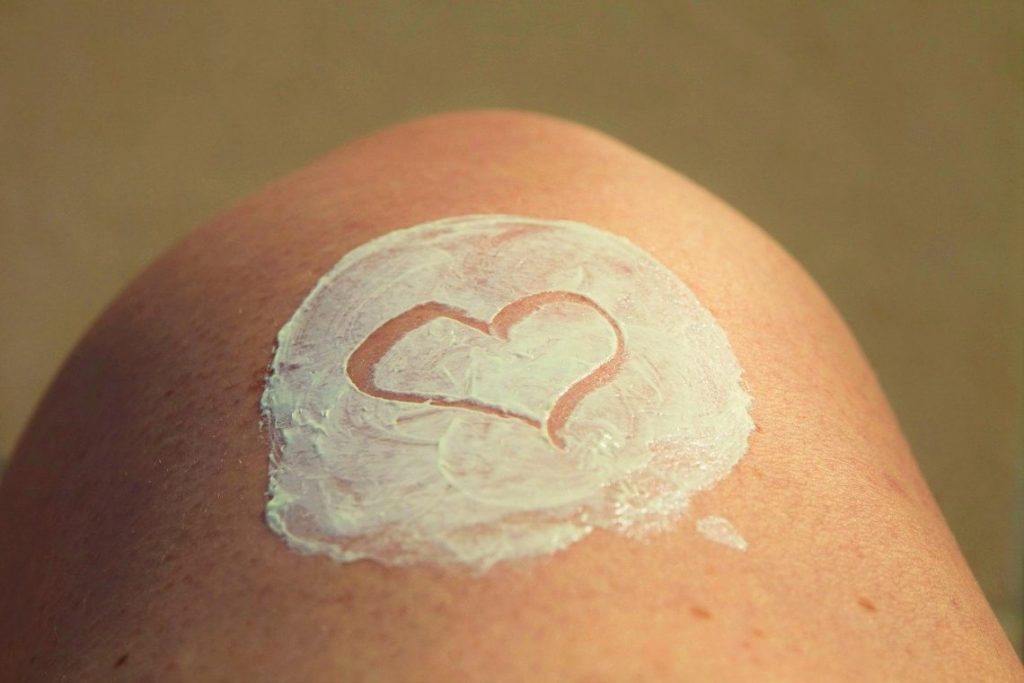
- True or false: All sunscreens protect against sunburn, but only those that are SPF 15 or above and are Broad Spectrum have also been shown to reduce the risk of skin cancer and early skin aging.
- True
- What is responsible for sunburn?
- UVA rays
- UVB rays
- Both
- How long does it take a sunburn to first become apparent after exposure?
- Immediately
- 0-3 hours later
- 3-6 hours later
- >6 hours later
Erythema is usually first noted 3 to 5 hours following sunlight exposure, peaks at 12 to 24 hours, and in most cases subsides at 72 hours.
- How should ruptured (popped) blisters from a sunburn be treated?
- Washed with alcohol and covered with band-aid
- Cleaned with mild soap and water and covered with wet dressing
- Left alone
- Covered with lotion
- Which provides more protection from the sun?
- A dark cotton shirt
- SPF 30 sunscreen
- A white t-shirt
- A wet t-shirt
Tightly woven, darker-colored fabrics provide more protection than sunscreen or a T shirt. A wet t-shirt provides very little sun protection. Equivalent to wearing SPF 4.
- In the US, what is the definition of sunscreen “water resistance?”
- SPF is maintained until showering with soap
- It will retain at least 50 percent of the labeled SPF after two 20-minute periods in water
- It will be more effective in water
- SPF is maintained after 40-80 minutes of activity in water or sweating
Option b is for Europe!
- What is responsible for photoaging (early skin aging)?
- UVA rays
- UVB rays
- Both
- True or false: tinted sunscreens are better than non-tinted sunscreens.
- True
Tinted sunscreen protects against visible light, too.
- True
- How much sunscreen is typically needed for adequate coverage of the body from head to toe?
- 1 teaspoon
- 2 teaspoons
- 1 tablespoon
- 2 tablespoons
AAD says typically 1 oz (a shot-glass)
- What is the minimum SPF in sunscreen that is recommended?
- >0
- 15-30
- 45-60
- 75
- What is sunscreen with zinc oxide or titanium dioxide?
- A physical sunscreen (works like a shield from the sun’s rays)
- A chemical sunscreen (works like a sponge for the sun’s rays)
- Neither
- What time should you especially seek shade from the sun?
- 8 AM– 10 AM
- 10 AM – 2 PM
- 2 PM – 4 PM
- After 4 PM
- True or false: you should look for sunscreen that also contains insect repellent
- False
Sunscreen should be applied often, while insect repellent should be applied sparingly and less often
- False
- True or false: Children less than 6 months old should wear sunscreen daily.
- False
Children <6 months should avoid sunscreen, and instead use protective clothing and shade. This is because sunscreen can be irritating to infants.
- False
- True or false: it’s good to avoid the sun entirely.
- False
Although sun can cause skin damage, some daily sunlight without sun protection early in the morning (before 10 a.m.) or in the late afternoon is important for proper absorption of vitamin D.
- False
- The FDA recommends that you do not use sunscreen products that have passed their expiration date. If there is no expiration date indicated, what should you do?
- Not use it
- Report it to the FDA
- Assume it is stable to use if it was purchased within the last 3 years and has been stored in a cool, dry place
- Assume it is stable to use indefinitely
FDA regulations require all sunscreens and other nonprescription drugs to have an expiration date unless stability testing conducted by the manufacturer has shown that the product will remain stable for at least three years
- True or false: you can get sunburned through a window.
- False
Window glass protects against UVB but not UVA. SO, you can still get a tan through a window!
- False
- True or false: a base tan can protect against skin cancer
- False
There is no such thing as a safe tan.
- False
- True or false: You can get vitamin D from a tanning bed.
- False
You may have heard that your body makes a lot of vitamin D when you use a tanning bed. It doesn’t. The bulbs used in tanning beds emit mostly UVA light; however, your body needs UVB light to make vitamin D.
- False
